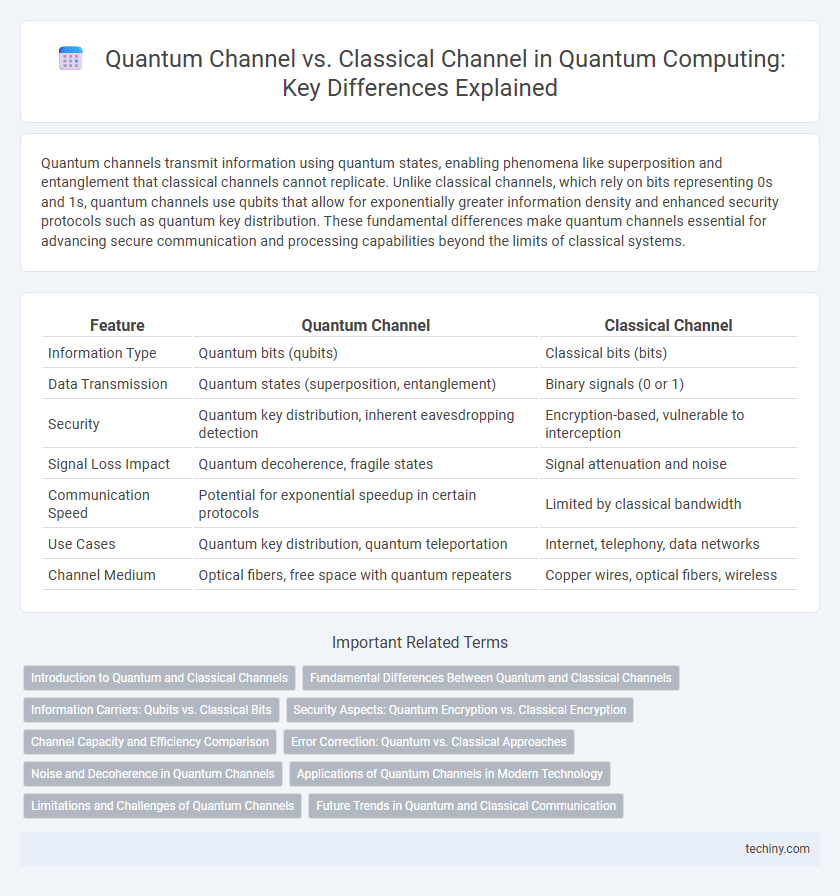Quantum channels transmit information using quantum states, enabling phenomena like superposition and entanglement that classical channels cannot replicate. Unlike classical channels, which rely on bits representing 0s and 1s, quantum channels use qubits that allow for exponentially greater information density and enhanced security protocols such as quantum key distribution. These fundamental differences make quantum channels essential for advancing secure communication and processing capabilities beyond the limits of classical systems.
Table of Comparison
| Feature | Quantum Channel | Classical Channel |
|---|---|---|
| Information Type | Quantum bits (qubits) | Classical bits (bits) |
| Data Transmission | Quantum states (superposition, entanglement) | Binary signals (0 or 1) |
| Security | Quantum key distribution, inherent eavesdropping detection | Encryption-based, vulnerable to interception |
| Signal Loss Impact | Quantum decoherence, fragile states | Signal attenuation and noise |
| Communication Speed | Potential for exponential speedup in certain protocols | Limited by classical bandwidth |
| Use Cases | Quantum key distribution, quantum teleportation | Internet, telephony, data networks |
| Channel Medium | Optical fibers, free space with quantum repeaters | Copper wires, optical fibers, wireless |
Introduction to Quantum and Classical Channels
Quantum channels transmit information using quantum states, enabling phenomena like superposition and entanglement that classical channels cannot replicate. Classical channels rely on binary bits transmitted through conventional media such as electrical signals or optical fibers. The fundamental difference lies in quantum channels preserving quantum coherence, which allows for secure communication protocols and enhanced computational capabilities.
Fundamental Differences Between Quantum and Classical Channels
Quantum channels utilize principles of superposition and entanglement to transmit information, enabling phenomena like quantum teleportation and secure key distribution that classical channels cannot replicate. Unlike classical channels that convey bits as definite 0s or 1s, quantum channels transmit qubits, which exist in probabilistic states, allowing for exponentially higher information density and parallelism. Measurement in quantum channels inherently alters the transmitted qubits due to wavefunction collapse, whereas classical channels preserve data integrity without such disturbance.
Information Carriers: Qubits vs. Classical Bits
Quantum channels utilize qubits as information carriers, leveraging superposition and entanglement to encode and transmit data in ways that classical bits cannot replicate. Unlike classical bits, which exist in definite states of 0 or 1, qubits can exist simultaneously in multiple states, increasing the capacity and security of quantum communication. This fundamental difference enables quantum channels to perform complex information processing tasks with higher efficiency compared to classical channels relying on binary bits.
Security Aspects: Quantum Encryption vs. Classical Encryption
Quantum channels leverage principles like superposition and entanglement to enable quantum key distribution (QKD), providing unconditional security against eavesdropping based on the laws of quantum mechanics. Classical channels rely on computational complexity for encryption, such as RSA or AES, which are vulnerable to potential attacks by quantum algorithms like Shor's algorithm. Quantum encryption ensures the detection of any interception attempts due to quantum state collapse, whereas classical encryption depends on mathematical hardness assumptions that may be compromised by advancing quantum computing technologies.
Channel Capacity and Efficiency Comparison
Quantum channels leverage quantum bits (qubits) to transmit information, offering potentially higher channel capacity through superposition and entanglement, which allow parallel state encoding beyond classical limitations. Classical channels rely on binary bits, with channel capacity constrained by the Shannon limit, while quantum channels exploit phenomena like quantum decoherence and error correction to enhance efficiency in transmitting complex quantum states. Efficiency in quantum channels remains challenging due to noise and error rates but can surpass classical capacities when optimized with quantum error-correcting codes and entanglement-assisted communication protocols.
Error Correction: Quantum vs. Classical Approaches
Quantum channels transmit qubits that are highly susceptible to decoherence and quantum noise, requiring specialized quantum error correction codes like Shor and Steane codes to preserve quantum information integrity. Classical channels rely on well-established error correction methods such as Hamming codes and Reed-Solomon codes, which handle bit flips and erasures more straightforwardly due to the binary nature of classical data. Quantum error correction must address unique challenges like no-cloning and superposition collapse, making its protocols fundamentally different and more complex than classical approaches.
Noise and Decoherence in Quantum Channels
Quantum channels are highly susceptible to noise and decoherence, which disrupt the fragile superposition and entanglement states essential for quantum information processing. Unlike classical channels that mainly contend with signal attenuation and external interference, quantum channels face unique errors such as bit-flip and phase-flip caused by environmental interactions. Advanced quantum error correction and fault-tolerant protocols specifically target these quantum noise sources to maintain coherence and ensure reliable quantum communication.
Applications of Quantum Channels in Modern Technology
Quantum channels enable secure quantum communication protocols such as quantum key distribution (QKD), ensuring unbreakable encryption in modern cybersecurity frameworks. They facilitate quantum teleportation, allowing the transfer of quantum information between distant nodes in quantum networks, enhancing distributed quantum computing. Classical channels, while essential for conventional data transmission, lack the capability to handle quantum states, limiting their application in emerging quantum technologies.
Limitations and Challenges of Quantum Channels
Quantum channels face significant limitations such as decoherence and noise that degrade qubit fidelity during transmission. Unlike classical channels, quantum channels require maintaining entanglement and coherence, which are highly sensitive to environmental disturbances. Error correction in quantum communication remains a major challenge due to the no-cloning theorem, restricting the ability to duplicate quantum information for redundancy.
Future Trends in Quantum and Classical Communication
Quantum channels enable secure information transfer through quantum entanglement and superposition, promising advancements in unbreakable encryption and ultra-fast data transmission. Classical channels, reliant on electromagnetic signals, continue evolving with improved bandwidth and lower latency using technologies like 5G and fiber optics. Future trends emphasize hybrid communication systems integrating quantum and classical networks to enhance cybersecurity and optimize communication efficiency.
Quantum Channel vs Classical Channel Infographic

 techiny.com
techiny.com